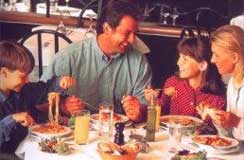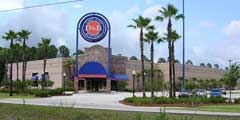
Vol. III, No. 5, May 2003
Let's Talk Food
Research by the International Council of Shopping Centers found that in 2002, visitors to enclosed malls spent an average of $4.70 per visit on food and beverage (F&B). That's an impressive per capita expenditure considering not every shopper makes a F&B purchase and many shoppers do not visit a mall with the intention of making a F&B purchase. That same research found that the average mall visitor spent an average of 78 minutes or 1.3 hours in the mall per visit.
 There
is no research on the average per capita expenditure for visitors to location-based
entertainment venues (LBE) such as family entertainment type facilities. Our
company's analysis of many existing centers indicates that the average F&B
expenditure is probably less than $2 per person. Yet, the average length of
stay is longer than at a mall, anywhere from 20% to 50% longer, from 1.5 to
2 hours.
There
is no research on the average per capita expenditure for visitors to location-based
entertainment venues (LBE) such as family entertainment type facilities. Our
company's analysis of many existing centers indicates that the average F&B
expenditure is probably less than $2 per person. Yet, the average length of
stay is longer than at a mall, anywhere from 20% to 50% longer, from 1.5 to
2 hours.
What accounts for this disparity between per capita food and beverage expenditures at these two different types of consumer destinations? We think the answer is rather obvious and simple -- most LBEs offer lousy food and beverage selection, presentations and settings. As a result, most guests leave LBEs with money in their pockets that could have become additional revenue and profits for the facility.
You might argue that is not the case, that guests are not as prone to make F&B purchases at LBEs as compared to at malls. But that's not a solid argument. We are familiar with a number of community-based LBEs that have achieved per capita F&B sales equaling or exceeding the average for malls, some as high as $7 per capita. At a number of those LBEs, F&B sales represent 40% or more of their revenues. If you have any doubts, just look up the data on Chuck E. Cheese's or Dave & Buster's, both public companies. At Chuck E. Cheese's, F&B revenue is two-thirds of total revenues and at Dave & Buster's, it's 50%. These are not isolated examples. We have examined the financial statements of many private LBEs that also achieve high F&B sales -- a far cry from the 10% or so F&B sales reported at most LBEs.
We believe there are two probable root cause explanations for why LBEs do so poorly on food and beverage:
- The owners and management are intimidated by food service, or
- Food service is considered a necessary evil.
You don't have to visit many LBEs to the see the consequences -- snack bars and concession stands with a boring selection of mediocre (at best) foods served by unenthusiastic staff with a bland presentation and a seating area with plastic furniture in a setting about as appealing as sitting in the middle of truck terminal. It's no wonder many LBEs do as poorly as they do with F&B sales.
What these LBEs don't realize is they are not only losing potential food service revenues, they are also affecting their overall attendance. There is one main reason a quality food and beverage offering positively affects attendance: Socialization and food and beverage go hand in hand. Most guests to LBEs are visiting as a group, whether they're a family or a group of friends. One of the primary reasons people go out together is to socialize. It's not just the entertainment that is their reason for going. In fact, it is often secondary to their desire to get away from their homes and socialize together. When the F&B component is missing or not of acceptable quality, the socialization opportunities are greatly diminished and the attractiveness of visiting is decreased. Why go, or go very often, if the LBE doesn't fully meet your requirements for going out?
Another impact of a poor F&B offering is that when it is mealtime, guests will leave the LBE for a restaurant rather than stay and eat. The less time guests are in an LBE, the less they will spend, just not on F&B, but also on entertainment. At meal times, many LBEs do little business as potential guests visit restaurants for their meals.
A poor food service offering also negatively impacts a guest's image of an LBE. The LBE can have the greatest entertainment in the world, but a poor food service component results in a lower image of the entire experience of visiting. A guest's overall rating of an LBE is the sum total of all aspects of their experience and rarely more positive than the weakest component.
A quality food and beverage offering can drive attendance at an LBE to be higher than achievable by the entertainment alone. To achieve this requires an F&B offering that in itself is a destination. Guests will come for the food, and while there, spend on the entertainment. It's the complete opposite of the traditional LBE formula of treating the entertainment as the anchor and the food as the impulse.
When properly executed, the combination of food and beverage and entertainment take on a unique synergy, where the resulting attendance exceeds what either one alone can achieve.
 The
synergy of the successful formula of combining food and entertainment is not
new to the LBE industry. In fact, this has been around for more than 25 years.
Dave & Buster's is just one example. Back in the early 1980's in Dallas,
Texas, Dave Corriveau owned Slick Willy's World of Entertainment
that adjoined James "Buster" Corley's restaurant named Buster's.
They both noticed that customers were going back and forth between their two
stores, so one day they decided to cut a hole in the wall between their businesses.
Sales increased for both, and the formula for Dave & Buster's
was born. The first Dave & Buster's opened in 1982 in Dallas
and is still operating successfully. Since then, 31 Dave & Buster's
have opened throughout the country. They are highly successful, achieving
average sales of over $200 per square foot. Even discounting the alcoholic
beverage sales, 17% of total revenues, their sales exceed $160 per square
foot. Many LBEs, especially traditional indoor FECs, are lucky to achieve
per square foot sales of half that amount.
The
synergy of the successful formula of combining food and entertainment is not
new to the LBE industry. In fact, this has been around for more than 25 years.
Dave & Buster's is just one example. Back in the early 1980's in Dallas,
Texas, Dave Corriveau owned Slick Willy's World of Entertainment
that adjoined James "Buster" Corley's restaurant named Buster's.
They both noticed that customers were going back and forth between their two
stores, so one day they decided to cut a hole in the wall between their businesses.
Sales increased for both, and the formula for Dave & Buster's
was born. The first Dave & Buster's opened in 1982 in Dallas
and is still operating successfully. Since then, 31 Dave & Buster's
have opened throughout the country. They are highly successful, achieving
average sales of over $200 per square foot. Even discounting the alcoholic
beverage sales, 17% of total revenues, their sales exceed $160 per square
foot. Many LBEs, especially traditional indoor FECs, are lucky to achieve
per square foot sales of half that amount.
Chuck E. Cheese's is another example of the winning combination of food and entertainment. In 1977 Nolan Bushnell created the first Chuck E. Cheese's Pizza Time Theatre in San Jose, California, which combined token-operated rides designed for small children, redemption games, an animatronics show, and that staple of every Stateside kid's diet -- pizza -- into one-stop destinations. Since then, Chuck E. Cheese's has grown to be a successful chain of over 400 consistently profitable locations achieving average sales of approximately $140 per square foot.
 Perhaps
the oldest indoor FEC in the country is Enchanted Castle in Lombard,
Illinois, a Chicago suburb. It started as a restaurant with a few games and
a nice party room in 1983 and through a series of expansions has grown to
50,000 square feet. Enchanted Castle features a 600 seat sit-down
family restaurant with three dining rooms offering food made to order. Harold
Skripsky, the co-founder and owner of the facility up until 1998, attributes
the restaurant as being an essential component of the successful formula.
Perhaps
the oldest indoor FEC in the country is Enchanted Castle in Lombard,
Illinois, a Chicago suburb. It started as a restaurant with a few games and
a nice party room in 1983 and through a series of expansions has grown to
50,000 square feet. Enchanted Castle features a 600 seat sit-down
family restaurant with three dining rooms offering food made to order. Harold
Skripsky, the co-founder and owner of the facility up until 1998, attributes
the restaurant as being an essential component of the successful formula.
There are other examples of successful LBE food and entertainment concepts, including Peter Piper Pizza, Gatti-Lands, Gatti-Towns, and Jillian's. In 2001 GameWorks came to the conclusion that one of the reasons their facilities were performing poorly was the lack of a quality F&B component that matched their targeted market, so they rolled out a new concept featuring a destination mid-scale restaurant. Even Disney has jumped on the bandwagon with ESPN Zone.
Our company has come to the conclusion from our research and experience that quality, destination food and beverage is essential to long-term success in the LBE industry. We believe new LBE developers that plan to present their food and beverage as a snack bar or concession stand are doing so at their own risk and that existing LBEs that want to succeed in the Third Millennium will need to upgrade their food and beverage offerings. If we had our way, the terms "snack bar" and "concession stand" would be banned from the industry's lexicon, an idea originally proposed by Harold Skripsky. To put it another way, we believe that entertainment alone is no longer a winning formula; that the future success of LBEs is in the combination of food and fun, or what we call "eatertainment."
Our company feels fortunate to be working on several exciting eatertainment projects that will take the concept to the next level for the family market. Projections are that one project will achieve a 50/50 mix of F&B and entertainment and achieve a much higher frequency of repeat business than entertainment alone can achieve.


